(January 25, 2011)
Dr. "Ishabaka" shares some tips on staying fit ands maintaining motivation.
Becoming fit and eating healthy food are the best preventative tools we have within
our own control. One reason fitness and healthy cooking play such big parts
on this site is that it is increasingly unlikely that the Medicare/Sickcare system
will be around long enough to cure us of all our lifestyle-related diseases.
In other words, we'll be on our own: we will need what I call radical self-reliance.
Rather than hoping we can acquire enough gold
or quatloos to fund costly healthcare for ourselves and our families in the future,
the better alternative is to avoid as many chronic lifestyle-related illnesses
as possible via fitness and healthy diet (i.e. eating real food only).
Dr. "Ishabaka" is middle-aged and fit. In an email "conversation," we discussed
the challenges of motivation, and the good doctor agreed to summarize his own
experiences and what he's observed in others.
The principles of fitness and nutrition apply to people of all ages, hence the
inclusive title of the entry.
Here are Dr. "Ishabaka's" suggestions:
Today is January 5th. I hadn't exercised for 11 days, and gained 6 pounds
over the holidays. Last night I decided it was finally time to do something,
and set my alarm so I'd wake up early and be able to go to the gym. When the
alarm went off this am I was SO tempted to turn it off and go back to sleep.
I made my way to the gym - it was leg day, my least favorite exercise day.
I felt like crap. My strength was down about 25%. Twice I felt like throwing up,
and once like passing out. I managed to finish. How I did so is the subject
of this article.
I joined my gym four years ago, as a result of a New Year's resolution to
get in better shape. Little did I know....
Every January, the gym is packed. I often cannot use the equipment I want -
someone else is using it. This lasts 4-8 weeks, then things go back to normal -
which means most people who joined in the New Year GAVE UP! Why? Because they
COULD NOT STAY MOTIVATED. I see this as THE number one issue in fitness in middle age.
There are some lucky people who truly love to exercise. I presume none of them
are reading this, so I'll dispense with them and address the rest of us, for whom
exercise is mostly a chore.
I think a major stumbling block is the concept of "getting in shape". It's
sounds like a project you can accomplish and finish. I think it's better to plan
on "staying in better shape" - it's a lifelong process. If you stop at any point -
no matter how "in shape" you were - well, just take a look at this picture:
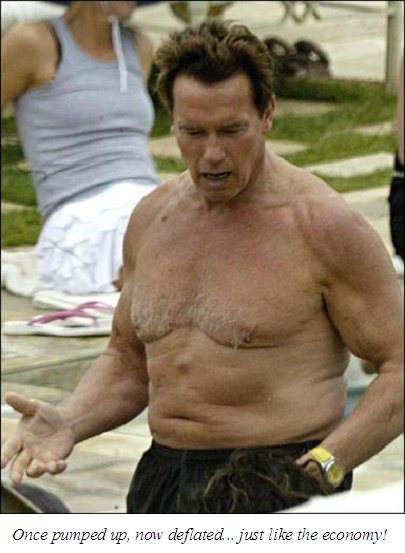
Again, to repeat - it's a lifelong process. Also, the concept
of "getting in shape" suggests that one is going to end up looking like a fitness
model - which is impossible for 99% of the population. If you're thirty pounds
overweight, and can only run one mile at 12 minutes per mile, losing twenty pounds
and running two miles at 11 minutes per mile is definitely " getting in better shape".
Another concept I find helpful is to compare overeating, eating unhealthy food,
and lack of exercise to an addiction, such as alcoholism. There is no "cure".
Improvement is possible in almost every case - but almost certainly, there WILL be
relapses. Relapses are often very demoralizing, and quite difficult to overcome.
Plan on them occurring.
Here are some strategies and tips I have found useful:
1. Try as many activities as you can before deciding what to concentrate on.
Try and choose at least one aerobic, and
one strength activity - your body needs both.
2. Get a workout partner. This has helped me more than anything. If possible,
choose someone who is fitter/more
knowledgeable, and push each other. It's a lot harder to turn off the alarm
clock if you've made an appointment
to go running/biking/to the gym with your workout partner in the morning.
A partner is particularly helpful when
you relapse - that's why A.A. has sponsors.
3. Join a class or a group. For some reason, women tend to do this and men don't.
Again, you will have a pre-determined time when you are supposed to exercise, and instructors and classmates to
urge you on.
4. Set goals for yourself. Write them down. Post them where you can see them
(I tape mine to the bathroom mirror).
I strongly believe in setting ACHIEVABLE goals. If you write down "lose 80
pounds", it's just too daunting, and
you'll likely give up.
Instead, write down "lose 6 pounds in 2 months". Unless you give up, you
will almost certainly achieve this, and
possibly lose even more than 6 pounds, which sets up what I like to call a
"virtuous circle", the opposite of a
"vicious circle". In a virtuous circle, success encourages further success.
5. Increase the intensity of your exercise in small increments. If you can curl
a 20 pound dumbell ten times when
you start, don't expect to be able to curl a 50 pound dumbell in a month.
Your initial goal should be to curl the
twenty pound dumbell eleven times. The same goes for
walking/running/biking/swimming speed and distance.
Realize that if you curl that same 20 pound dumbell ten times for two years -
you aren't going to make any
progress. I call this "going through the motions", and it's surprising how
many people at my gym do this. I think it's
a form of self delusion: "Well, I worked out at the gym today", when the
person really didn't push their body at all.
One big hurdle many face - myself included - is what's called "delayed onset muscle soreness" or DOMS. This is muscle
pain that comes on a while after exercise. In my thirties, I found it maxed out the day after. Now it's two days after.
I wonder if it will be three days after in my sixties? It definitely helps to ease into exercising - the worst thing you can do
is go crazy your first session, and wind up bed ridden for a week. Nonsteroidal anti-inflammatory drugs such as
ibuprofen (Motrin, Advil) don't seem to help. Stretching may or may not help, depending on who you read.
One thing I have found - it sounds counter-intuitive - is that it's best to resume exercising before all the pain is gone.
If I wait till I'm 100% pain free, the cycle seems to just repeat itself. If I resume when the pain is mild -
moderate, I seem to adjust, although I'm always a little achy somewhere.
6. Enter a competition. This gives you a goal AND a time period in which to get
in shape. I suggest a 5 kilometer
(3.2 mile) run. They are held all the time just about everywhere. Even if
you can't run non-stop for 5 kilometers, you can do what's
called "run-walking" - run until you are tired, walk until you recuperate,
then run some more. I guarantee you
won't win your first 5k (and probably will never win one), but you won't be
last - and you will get a cool finisher's
t-shirt to wear, that will make people think you are really in shape!
7. Spend the minimum amount of money possible, at least in the beginning.
Sign up for a one or two month trial
membership at a gym if you've never belonged to one - you don't know if
you'll like it or not. Don't buy a
$3,000 triathlon bicycle for your first triathlon - use your ten year old
mountain bike. You're goal is just to finish.
If triathlons turn out to be your thing, you can always buy the expensive
bike later. The attics, basements, and
second hand shops of America a littered with expensive exercise equipment
people bought and abandoned.
The ONLY exception I would make is shoes. I'm assuming people reading this
are middle aged, and although we
may say "Fifty is the new thirty", our bodies don't agree - they have fifty
years of wear and tear on them.
Slamming fifty year old feet (likely carrying excess poundage) in poorly
cushioned, poorly supporting shoes, on
concrete, over and over again, is likely to cause injury. Injury is perhaps
the single most demoralizing thing that
can affect a fitness program. For that reason, I suggest consulting a
doctor first if you have, or are at risk of serious
health problems, starting gradually, progressing incrementally, and NOT
neglecting flexibility and balance.
The number one cause for admission to nursing homes in the U.S. is falls,
and maintaining good balance and
flexibility will minimize the likelihood of a fall happening - and - if one
does happen - the likelihood of serious injury.
8. Finally, when I'm really demoralized, sometimes I'll tell myself "Just do
some damn thing for a little while".
Whether it be a thirty minute walk, one mile run, or half an hour at the gym,
it's better than nothing, and seems to have
a surprisingly positive effect on getting me out of a funk.
Thank you, Doctor, for sharing your experiences and tips. Here are a few links
and comments of my own on the subject.
Stretching is good. Flexibility improves health, and stretching helps
with back pain and other conditions. It's also a form of exercise, and the warmup
provided by stretching often gets you in the mood for further exercise.
Yoga, tai chi and chi gung also improve balance, which tends to degrade with age.
Learning how to fall is good. I know Dr. "Ishabaka" is also a martial arts
practitioner, and one of the most valuable things I have learned in martial arts
is how to fall: lower your center of gravity, tuck your head down and roll.
Muscle mass is a factor in cardiovascular health. Studies have shown that
the quantity of muscle one builds and retains is a predictive factor in overall
health. Walking is good, but keeping upper-body muscles requires more than walking.
Avoid temptation by keeping your kitchen free of junk food and packaged snacks.
If it's not around, you won't crave it as much. "You don't miss what you no longer want."
Push yourself gently, don't hurt yourself. Wake up slowly, stretch,
warm up, know your limits and push up to them but not past: common sense, to be
sure. Patience and perseverence go hand in hand.
Self-discipline is good. I have a number of "bad genes" as the men in our family are prone to heart disease,
high cholesterol and high blood pressure. So it takes more work on my part to
counteract these negatives. At 57, discipline is required.
Avoid "sacrifice," seek positives. Americans are trained to worship
instant gratification and ease. As a result, many see eschewing ice cream etc.
as "painful sacrifices" and arduous exercise (which results in so little immediate
gain) as equally painful and unpleasant.
I don't think of what I'm setting aside; I "reward" myself if I fulfill my fitness
goals. So there's no "sacrifice," only "rewards."
Some exercise is better than none. If I'm really tired, then I'll walk
2 KM, about 20 minutes. My goals are higher, but some days I can't muster the energy.
But doing some exercise makes me feel good.
Work burns calories. Gardening, housework, etc. burns a lot of calories.
But those activities don't offer cardio-workouts; they're not enough, but they
can certainly reduce weight.
Work up to higher levels slowly and comfortably. I once read the story of
a 60-ish woman who was out of shape. She started walking one block a day, then
slowly added distance. Eventually she tried jogging a block. Slowly, she ran
a bit longer as it felt comfortable. After some time, she was running several miles
and enjoying it.
The form doesn't matter, the routine matters. It doesn't matter if it's
yoga, tai chi, chi gung, walking, biking, swimming, etc., it's making it part of
your routine so you miss it if you don't get to do it.
Cross-training is good, especially as you age. Like many others, I see
cross-training as common-sense. I don't run more than once or twice a week,
but bike every day and walk some distance a few times a week. Ditto pushups
and some other muscle-building stuff.
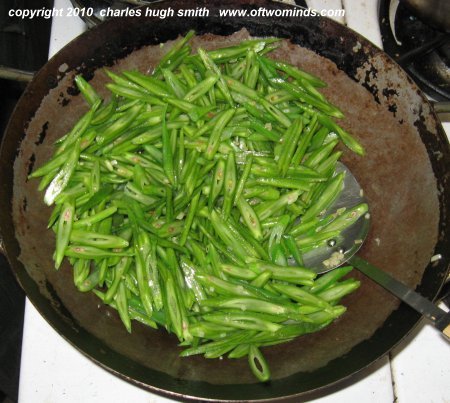
Eat less, and eat more filling, low-calorie veggie snacks and dishes. Duh, right?
But the human body is extremely efficient, and it's
ridiculously arduous to burn 500 calories, and ridiculously easy to consume 500
calories.
BMI calculator.
Due to routine effort, my BMI is 21.8 and I can pass the Army Physical Fitness Test
for active-duty men 20 years my junior. Is it easy to stay at this level? Heck no!
I just don't have any other choice. If I looked like Arnie while
preaching fitness and healthy eating, then I'd be undermining the entire message:
we are what we do every day.
(Please see my article Improving Americans' Health, With or Without Health Care Reform for more.)
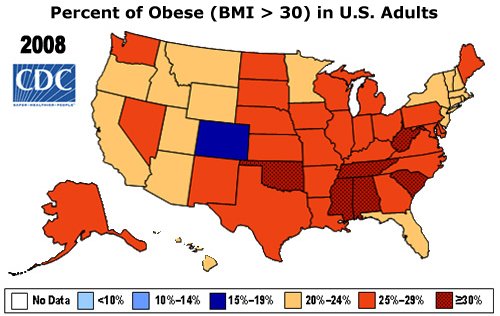
The cost of treating heart disease and stroke in the United States is
expected to triple in the next 20 years, to $818 billion, a new report says.
To curb this rise in costs, the panel said that "effective prevention strategies a
re needed if we are to limit the growing burden of cardiovascular disease."
American Heart Association CEO Nancy Brown said in a news release that "unhealthy
behaviors and unhealthy environments have contributed to a tidal wave of risk
factors among many Americans. Early intervention and evidence-based public policies
are absolute musts to significantly reduce alarming rates of obesity, hypertension,
tobacco use and cholesterol levels."
Right now, 36.9 percent of Americans have some type of heart disease, including
high blood pressure, coronary heart disease, heart failure, stroke and other
conditions. By 2030, that number will rise to 40.5 percent of the population, or
about 116 million people, according to the report.
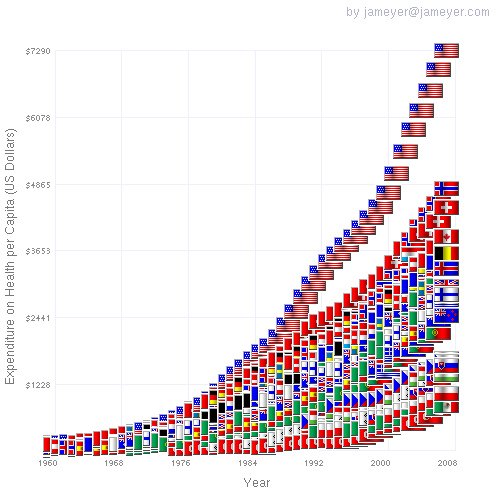
Fat, Sick And Nearly Dead: How One Man Took Control Of His Eating Habits
"I hate exercise, but I like the results." (RIP Jack LaLanne)
A Factor of Success As Adults: Self-Control
Hungry? Your Stomach Really Does Have a Mind of Its Own
Nestle Scientists Try To Train the Brain in the Gut To Feel Full With Less Food
It's good to have goals, even if we can't quite meet them fully:
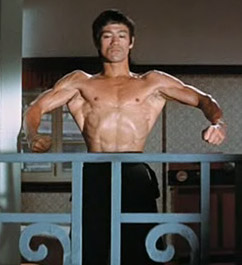
"Without health there is no happiness. An attention to health, then,
should take the place of every other object." (Thomas Jefferson, 1787,
via Ken R.)
If you would like to post a comment, please go to
DailyJava.net.

Order Survival+: Structuring Prosperity for Yourself and the Nation or
Survival+ The Primer
from your local bookseller or in ebook
and
Kindle formats.
Of Two Minds is also available via Kindle:
Of Two Minds blog-Kindle

"This guy is THE leading visionary on reality.
He routinely discusses things which no one else has talked about, yet,
turn out to be quite relevant months later."
--Walt Howard, commenting about CHS on another blog.
NOTE: contributions are acknowledged in the order received. Your name and email
remain confidential and will not be given to any other individual, company or agency.
|
Thank you, Robert R. ($60), for your extraordinarily generous contribution
to this site--
I am greatly honored by your support and readership.
|
|
Thank you, Richelle L. ($50), for your outrageously generous contribution
to this site--
I am greatly honored by your support and readership.
|
Or send him coins, stamps or quatloos via mail--please
request P.O. Box address.
Subscribers ($5/mo) and contributors of $50 or more
this year will receive a
weekly email of exclusive (though not necessarily coherent) musings and amusings,
and an offer of a small token of my appreciation:
a signed copy of
a novel or
Survival+ (either work admirably as doorstops).
A number of readers requested a $10/month option, so one is provided.
The "unsubscribe" link is for when you find the usual drivel here
insufferable.
Your readership is greatly appreciated with or without a donation.
For more on this subject and a wide array of other topics, please visit
my weblog.
All content, HTML coding, format design, design elements and images copyright ©
2011 Charles Hugh Smith, All rights
reserved in all media, unless otherwise credited or noted.
I would be honored if you linked this essay to your site, or printed a copy for your own use.



